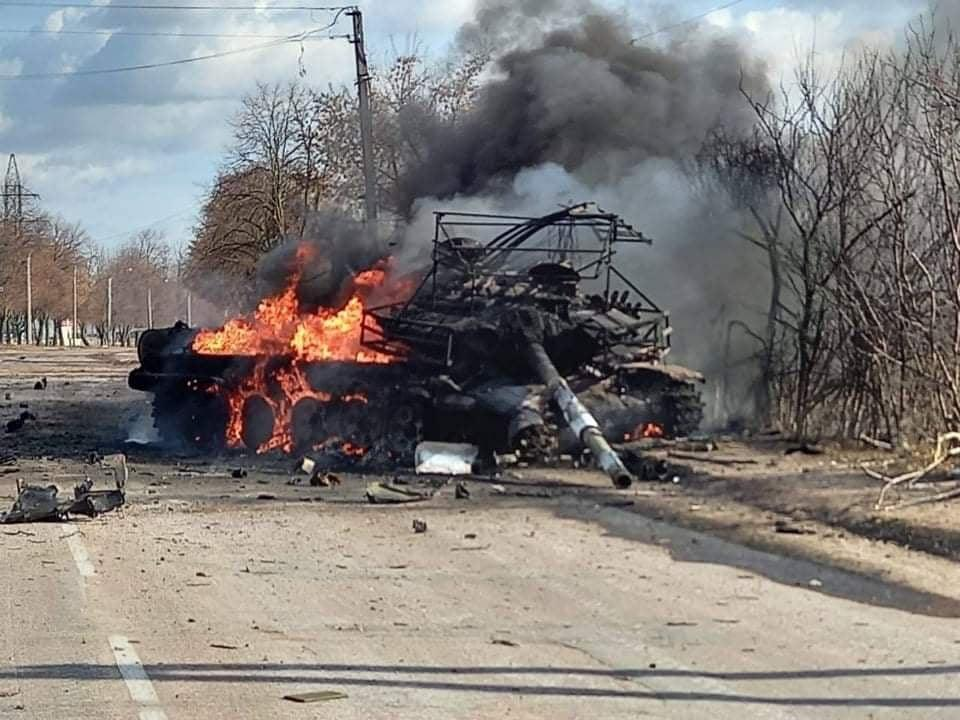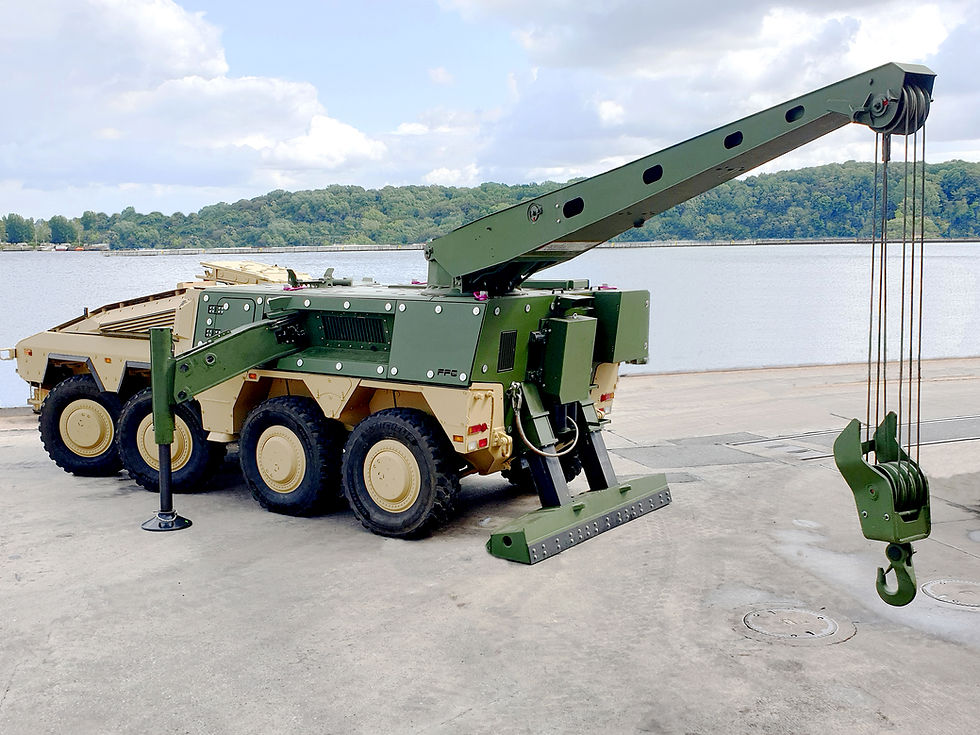Russian turret cages
- Jon Hawkes

- Feb 28, 2022
- 5 min read
Updated: Mar 6, 2022
A short note on the curious Russian tank roof mounted bar armour packages seen in Ukraine of late, purportedly there to primarily defeat Javelin ATGM attacks. This is an offshoot of my primer on statistical armour, which you can read here.

It is not entirely clear what Russia is specifically seeking with these armour cages, and everything out there is variously informed and uninformed conjecture so far. If they are indeed orienting primarily at defence against Javelin, as reported, the broader discussion on the lack of efficacy of bar-type armour against ATGMs in my primer on statistical armour endures, and the benefit remains quite limited.
Very limited evidence to date (which is to be taken with extreme caution in terms of drawing conclusions) suggests their use in Ukraine has not been glowingly successful. Equally, as I caution, there is essentially no footage of these engagements, and photos like the one below captioned "T-72 blown up by a Javelin" offers no actual evidence it was even hit by a Javelin, let alone an assessment of how the Javelin interacted (or didn't) with the roof cage. Maybe it was just burned having been abandoned. Useful video evidence of these engagements will more than likely be months away, if that. So, caution all round in drawing conclusions.

Why might this armour be a poor choice vs. Javelin?
Javelin has two flight profile modes, direct attack and top attack. If direct attack, the flight path will be relatively flat, and the missile will impact on the side of the vehicle, making these roof cages irrelevant and the engagement being one of side armour (plus ERA modules, if present) vs the warhead.
The normal mode for engaging tanks at range is top attack, where the missile lofts then drops down on the target from above. This provides the missile with the best thermal picture with least likelihood of obstacles to its view and flight path, and means it impacts on some of the weakest armour on any AFV on the roof or decks. This is what this armour appears to be trying to defend against.

Javelin uses a contact fuze unlike proximity fuzes on systems like the TOW-2B, so detonates when it strikes something, which suggests a statistical armour might be useful. However, it is not the piezoelectric system of an RPG which can be defeated by crushing the warhead in a cage or bar matrix, it is just a good old contact fuze. The missile is also 127 mm in diameter, much larger than any bar armour design's grid and in any case there is no cone to crush even if the cage geometry were optimised for Javelins.
In essence, there isn't a particularly logical way these cages would defeat a Javelin-type missile.

The most likely outcome is that the missile would detonate on the cage, which gets people excited as they say the additional distance will result in breakup of the jet formed by the warhead and a failure to penetrate the armour.
That doesn't stand up to much logic either - Javelin has a tandem warhead with a capability of over 750 mm of RHA penetration, and even if we assume a significant (hypothetical and optimistic) disruption to its efficacy by the space between the initiation and the turret itself, as well as accounting for advanced explosive reactive armour (ERA) blocks potentially being present on the turret roof, there is likely to be at least 300 mm of penetration remaining to work with, against a roof armour perhaps 30-50 mm thick (depending where it impacts).
There is nonetheless a (low) chance that the specific interaction of the missile and the bar armour could result in it damaging or destroying the missile prior to it initiating, though some (quite likely propaganda-laced) tests by Ukraine recently suggested the armour is as ineffective as suspected. I'd strongly caution against taking much from these tests, given their context during the build-up to conflict with Russia, their limited scope and total lack of publicly facing scientific documentation.
If it's not for ATGMs, is it for something else?
A few have suggested it is also substantially or even primarily oriented towards unmanned aircraft threats, notably the TB2 UAV firing MAM missiles which have been used to great effect in Syria and Nagorno-Karabakh recently. Again, the logic doesn't change here.
MAM series missiles (MAM-L, MAM-C and MAM-T) use contact/proximity fuzing, and so are much the same as any ATGM - they will wither detonate on or before the cage and offer such overmatch as to be largely uncaring of the additional standoff that has been created by the cage.

There have been suggestions that it could be oriented more towards the 'DIY drone' threat as seen extensively in recent years across Syria and Ukraine, where commercially available quadcopters and small remotely operated aircraft are retrofitted to drop grenades or more commonly small calibre mortar bombs.
This is perhaps the most useful application for the armour, albeit it no longer functions as statistical armour anymore. Neither grenades nor mortar bombs have the shaped charge warhead nor RPG fuzing to defeat via statistical methods, so the cage is simply acting as a standoff screen which these threats land on and either roll off the vehicle or detonate on rather than the roof itself.
Barring a few large calibre mortar examples, as they are HE/frag threats and not shaped charges getting a bit of standoff can be useful to mitigate the effect on the vehicle, though at the expense of potentially creating a better spread of fragmentation over the vehicle, causing more damage to optics, antennas and other vulnerable components than might happen if the blast were localised by being directly on the armour. But in neither case is it likely there will be a penetration or substantial behind armour effect on something as heavily armoured as a tank.
The bigger picture.
Given there is a tiny chance of this armour being helpful in niche circumstances, it is in isolation a useful addition - every (very) little helps with surviving in a battlefield. But real life is not a blinkered environment, and the broader implications of fitting an armour package like this need to be considered.

It is a significant amount of weight on the top of the vehicle, changing turret and vehicle balance, and putting additional strain on the turret drives and stabilisation system. It is not an insubstantial structure, and radically increases the silhouette and profile of a tank that had previously had low profile as one of its key strengths.
Not being spotted is one of the first layers of survivability, and this quite significantly alters that strong advantage the T-72/90 series of tanks has always had.

In respect of the Russian roof statistical packages, so far the (admittedly very patchy and unreliable) evidence from operational usage in Ukraine suggests the armour is not proving especially effective, and a more considered view of the overall picture might suggest it a poor return versus the literal and figurative costs.
Aside a low probability defeat, the main benefit of the armour may be a 'soft effect' - increasing the confidence and morale of tank crews advancing into known high density Javelin defended areas. Time may tell how effective they really were when this conflict is over and increased footage and information emerges.





Just a slight correction that does not really change anything but the 40mm NATO grenade does have a shaped charge hollow core. A very pathetically small one but it's there for HEDP.
Do the Ukrainians use RPG-7s? From what little I've seen of the cages, they seem designed to stop PG-7 or similar projectiles from above at 90° from the front of the vehicle (i.e. exactly from the sides). That would be useful when engaging in an urban environment where the enemy is trying to shoot PG-7s from buildings (presuming blowback allows it). But the placement of the bars would make it ineffective from other angles. So, unless it's in an arc above the vehicle from one side to the other, it's probably going to fail.
Then again, if Ukraine doesn't use RPG-7s or similar my entire theory falls apart.
as an alternative view on cages. Might it be that the cages are not intended to stop a missile at all. Rather that the cages are designed to permit open hatch operation in urban settings.
situational awareness in a closed down tank is v. v. limited and the Russian tanks observed appear to have v limited or non existent modern remote camera stations to permit closed down operation. Indeed a tank, closed down in an urban battle has been shown recently to be v vulnerable unless supported by dismounted infantry. Individuals have been seen in online videos virtually walking up to tanks and lobbing explosives at the tank.
The cage makes sense then to prevent thrown ordnance, Molotov cocktails et…
I had read on some Russian blogs that the cages aren't designed to stop a missile at all but rather mask the heat signature of the tank's engine from the top down sensors of ATGMs and cause them to overshoot. Whether this is true or not remains to be seen.
A Rafael representative told me at Eurosatory that Spike (SR) has a proximity fuse. My guess is it could be a (rather exotic) electrostatic fuse. So if Spike has a prox fuse to get the spacing right and to defeat bar armor, then maybe some Javelins have one as well, without it being disclosed.
BTW, a thing you overlooked: The precursor shaped charge is not coaxial to the main shaped charge to the latter does not get disturbed by the former's effects on armor. Russian light ERA tiles are rather small, so adding bar or spaced armor in front of small ERA tiles might lead to precursor charge triggering a different tile than the main charge encounters.